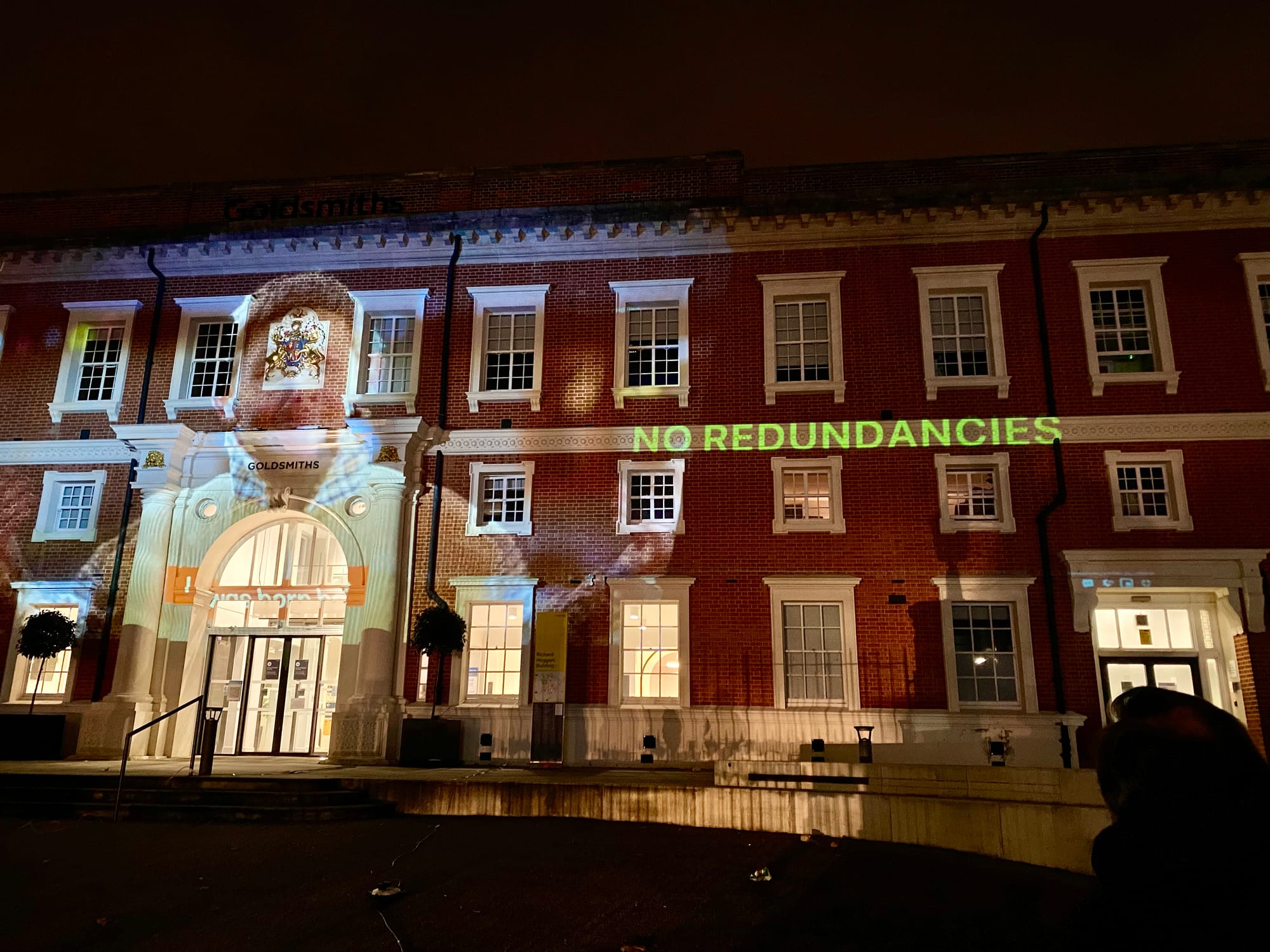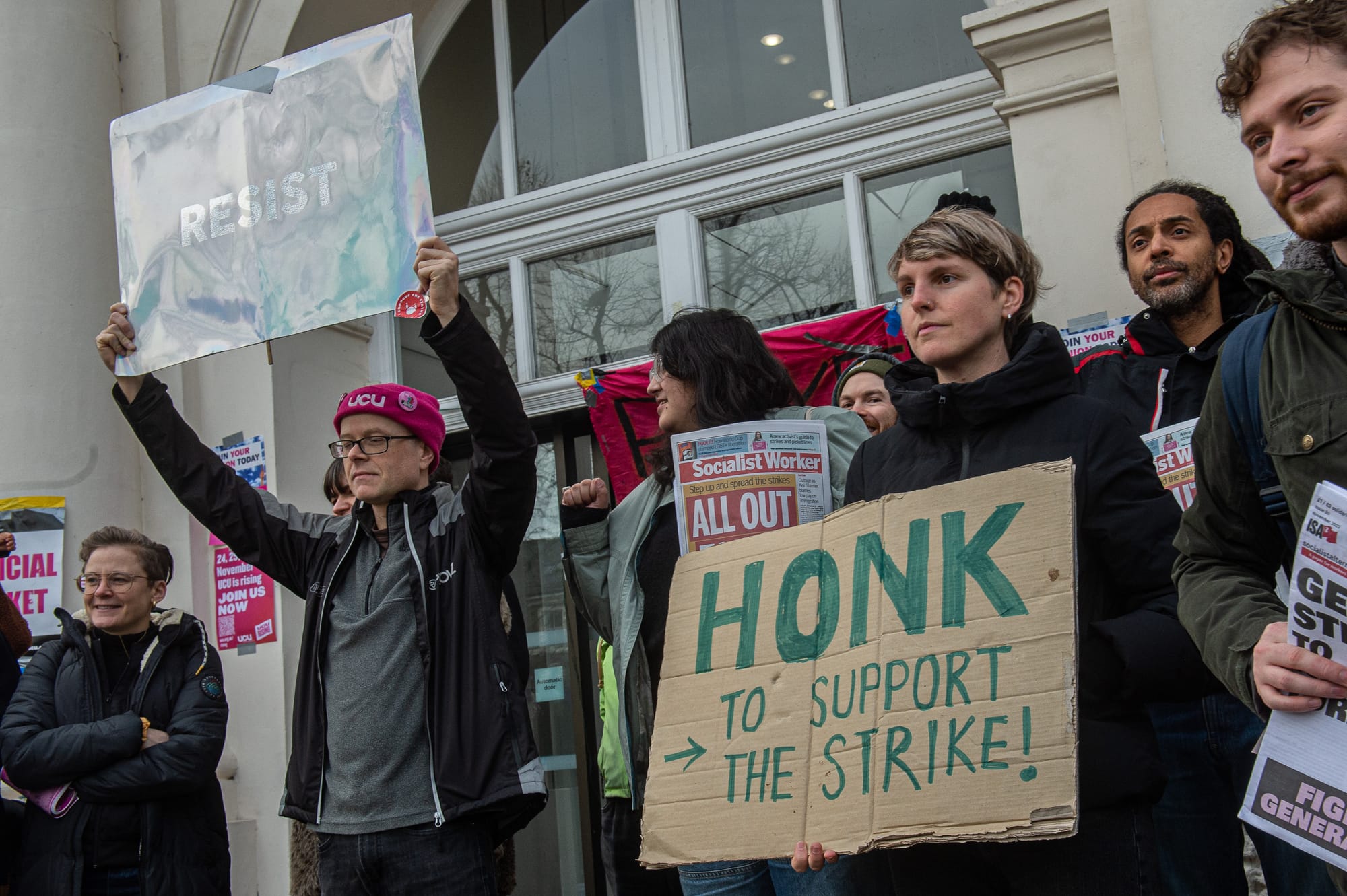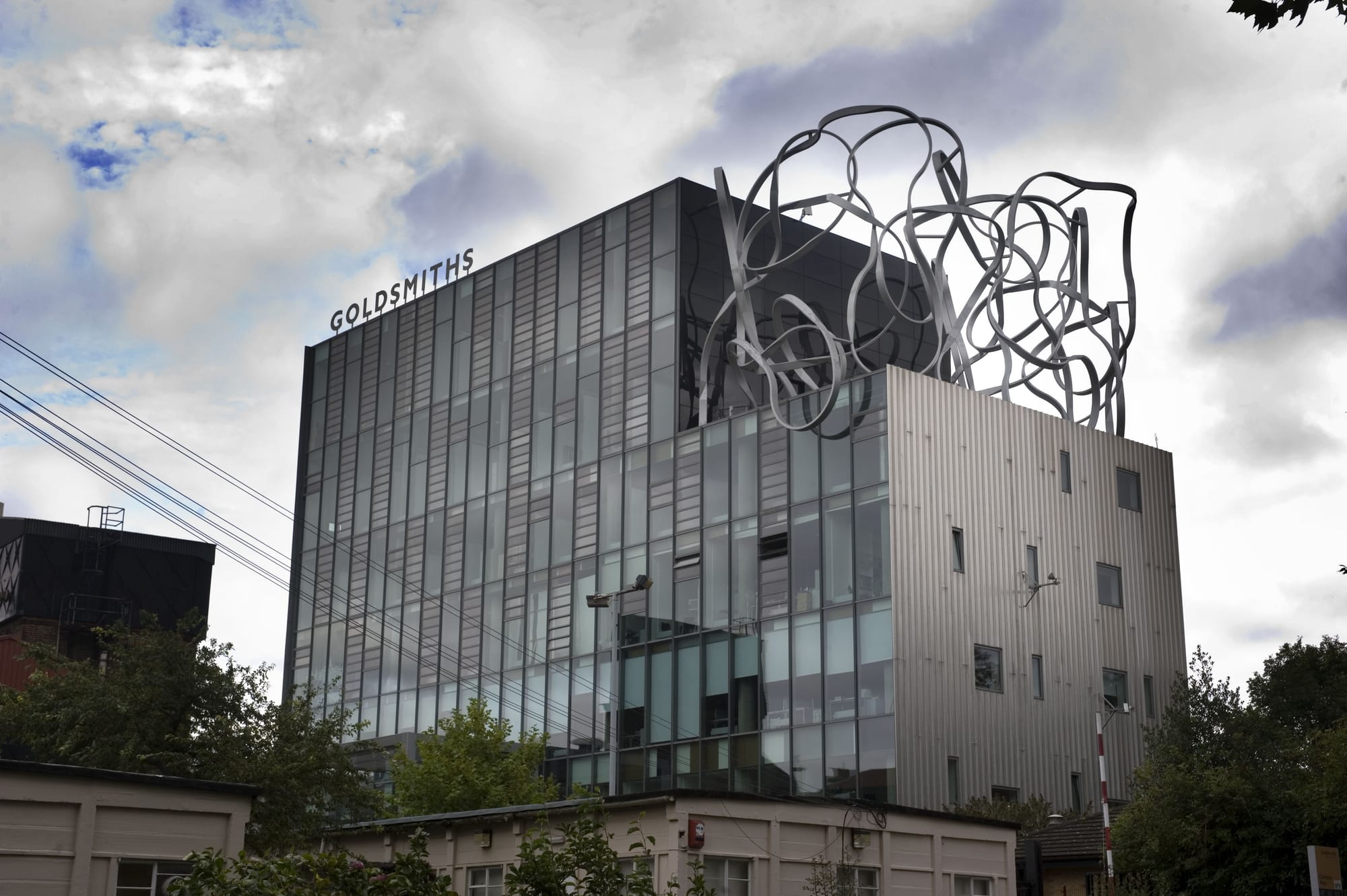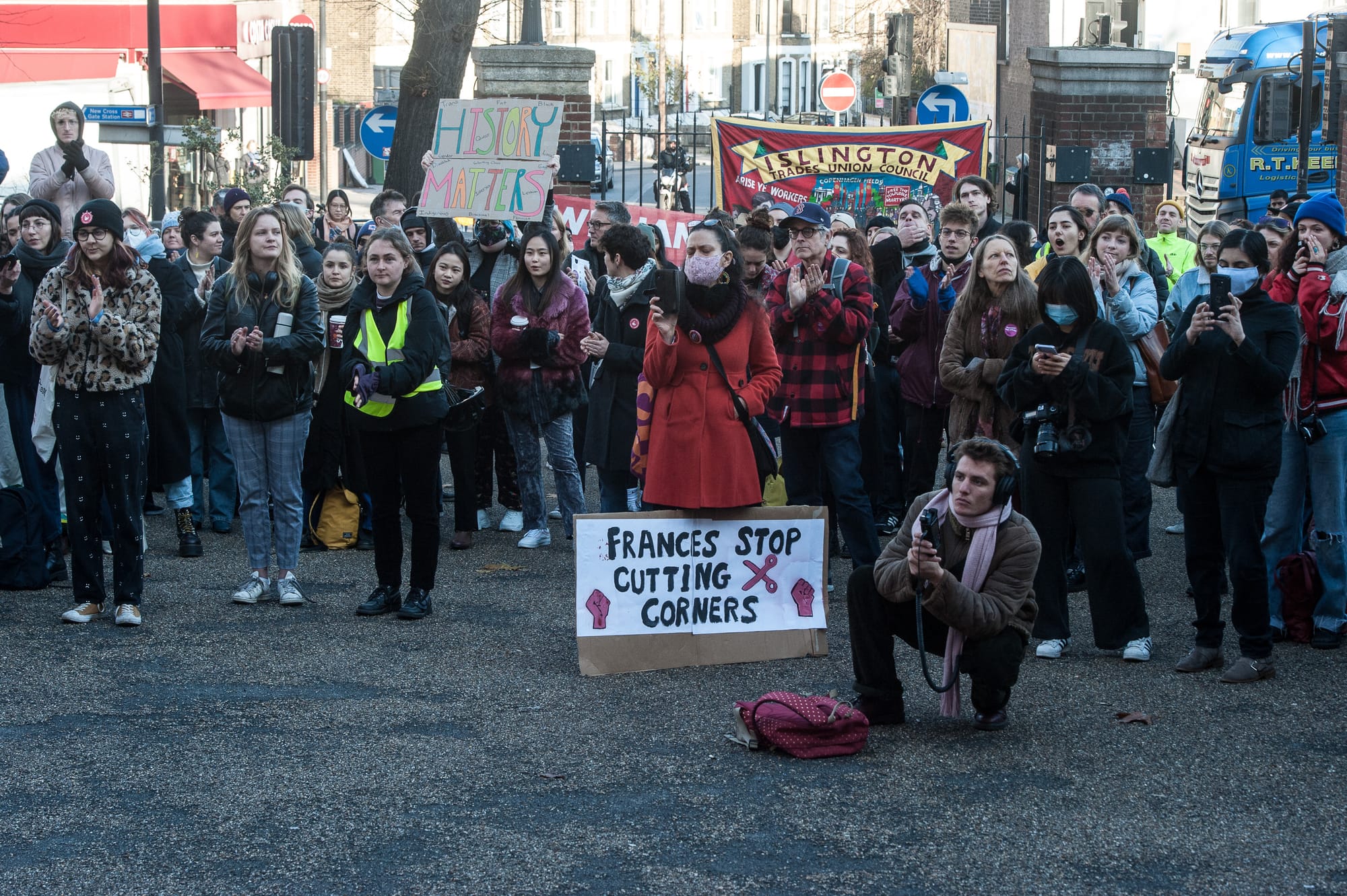“We’re running a shop,” says Goldsmiths’ executive dean, Stephen Graham, “and the shop sells products: degrees. And we need to get enough people to come in and buy those products. And at Goldsmiths, we haven’t had focus on … talking about markets and students as consumers and so on. You’re sort of not really allowed to do that at Goldsmiths.”
It’s late October and we’re sitting in Graham’s office at Deptford Town Hall, a grand, baroque structure first built in 1905. During World War I, conscientious objectors were secretly tried here; later, it became the headquarters of the historic Metropolitan Borough of Deptford. Since being acquired by Goldsmiths in 2000, the building has been used for readings and lectures, though many students will remember it as the site of a 137-day occupation by campaigners from Goldsmiths Anti-Racist Action in 2019.
Goldsmiths built its reputation on this radical image, but today, this image is under threat. In the summer, the university’s council voted on a controversial round of redundancies that resulted in the loss of 62 academic staff. Goldsmiths is not the only higher education institution making cuts right now — there are currently 75 British universities undertaking redundancy and restructuring programmes — but what is unique, according to the University and College Union, is their scale and severity, which they described to me as “one of the worst restructures at any UK university in the last academic year.”
For Goldsmiths’ academic staff and students, the 62 job losses are the latest development in a half-decade of instability at the university. Since 2019, Goldsmiths has been undergoing a restructuring process that has seen cuts to staff, research, and professional services. Management says that the university needs to be more efficient in the face of declining student numbers, a plateauing international intake due to a tightening of visa restrictions by the previous government, and domestic tuition fees not rising in line with inflation. By doing so, they say they have staved off a financial disaster that threatened the university’s existence.
But some argue that these efficiency measures have been reckless and poorly implemented. Anecdotes from spring this year suggest a febrile atmosphere where management has become widely distrusted. Staff have confronted them whilst they were out with their kids, they have been attacked on social media and have had to put alternative plans in place to prevent meetings being disrupted. Perhaps more importantly, these cuts have threatened what makes Goldsmiths’ character so unique. For the last couple of weeks, I’ve been on campus speaking to students, management, and current and former staff, wondering how inevitable this all was and whether, post cuts, Goldsmiths is still Goldsmiths.

Few other universities in London, or indeed nationally, can boast quite the same legacy. Notable alumni range from Damien Hirst to Vivienne Westwood, Lucian Freud to Steve McQueen. Its lecturers have included award-winning writer Blake Morrison and celebrated theorist Kodwo Eshun. It’s not simply a university that’s attractive to arts and humanities students but a specific subset of those students who want to study in a Goldsmithsian way.
When I was offered a place on their Fine Art course nine years ago, I felt blessed. The interview process — partially conducted by students — felt almost arbitrary, like getting into Berghain. Mediums such as sculpture and painting weren’t segregated like at other colleges, and neither were age groups. At that time, the cultural theorist Mark Fisher was still giving his ‘Popular Modernism’ lectures, which students dotingly audited from window sills and the theatre steps, and the renowned anthropologist David Graeber had only recently left his post at Goldsmiths for LSE.
It’s hard to pinpoint when the university’s financial difficulties began. The current warden, Frances Corner OBE, claims that problems had set in long before her tenure kicked off in 2019. In 2013, for example, a cap on student numbers was lifted, allowing Russell Group institutions to expand and hoover up students who would have otherwise studied at universities like Goldsmiths.
On the other hand, many others argue that the problems started with Corner herself. Corner had previously headed the London College of Fashion, and was a board member of Centerpoint, the youth homelessness charity. She seemed like a good fit — but it didn’t take long for her to get on the wrong side of staff. In autumn 2019, in a video circulated on the Friday staff email, Corner sat in an empty lecture theatre describing how she was going to begin restructuring Goldsmiths. She called it ‘Evolving Goldsmiths’.
“It was very empty and very nebulous,” one academic tells me, “so nobody really knew what it meant. But, of course, it meant cuts. It meant mergers.” Les Back, a sociologist who left Goldsmiths in 2022 after 28 years as a professor and ten years as a student tells me, “That was the warning sign.” The ‘Evolving Goldsmiths’ plan proposed cuts of 10-15% reduction of all departmental budgets across academic and professional services. Plans to build an expensive new ‘enterprise hub’ led to accusations of misplaced priorities (the project was ultimately cancelled in 2021, but not before forcing the closure of the Out of the Brew café and Prangsta costume shop on New Cross Road).
Goldsmiths tell us that only a couple of years earlier – in 2019 – they had noticed a decline in student applications, which they predicted would continue as a trend. They added that the "plans we put in place were aimed at anticipating and responding to both a challenging financial environment and ensuring that Goldsmiths' finances were both stable and sustainable.”
In 2020, Covid compounded Goldsmiths’ problems. A recovery plan was put in place and, according to its University and College Union (GUCU)’s Finance Working Group, an agreement was made with NatWest and Lloyds to restructure existing loans and provide extra credit to cover unexpected cash shortfalls.
As a Goldsmiths spokesperson explains, in order to access “more favourable conditions” for this financial support, they were told they would need to undertake an independent business review (IBR). Goldsmiths commissioned KPMG to undertake this review but GUCU still doesn't know exactly how much money Goldsmiths paid them for it or subsequent work.

In 2021, The Guardian reported that the university had announced 52 compulsory redundancies to tackle its financial challenges. The GUCU responded with 37 days of strikes across 2021 and 2022 — an unprecedented level of industrial action. “It was like being in the midst of a kind of academic Civil War,” Les Back says. “It was so tough.”
Though 2022 was much quieter, it also brought news that stuck in the craw of many staffers and students: a report in The Tab suggested that Frances Corner had spent nearly £20,000 of university money on taxis since taking her post. (Corner tells me that this was due to Covid — she was required to take taxis because she couldn’t take public transport. “That was all done above board, and there were particular reasons to do with personal circumstances, not necessarily my own,” she says.)
But things reached a head in October 2023 when a shortfall of students was discovered, leading to £13.1m less projected income in the annual budget. In response, Goldsmiths announced a ‘Transformation Programme’, and management had to make some unpopular decisions. “Disaster,” Graham says of that time. “Total disaster…We were almost in a bunker, going, ‘What the hell do we do? We need to save this institution.’” Graham describes these meetings as some of the toughest he’s ever been in. “They were desperate because we all saw the writing on the wall.”
At first, management pursued less painful measures. According to information circulated to GUCU members, the removal of open job vacancies saved around £3.5m, then a voluntary severance scheme brought in £4.2m which, the college factored, wouldn’t be realised for a year or so. Further reductions in areas like research expenditure totalled recurrent savings of £10.1m. (When I asked Goldsmiths to clarify if these figures were accurate, they refused to “fact check sentences that are out of context”.)
But it was agreed that more money was needed for contingency purposes, and roughly £7m of extra savings was sought on top of the £13.1m shortfall, bringing the total to roughly £20m. “Everyone said to us, ‘Why £20m?’” says Graham. “And that was the most difficult thing to get across, because everyone perceives the £7m extra as just a nest egg, and it really, really wasn’t.”
Instead, Graham asserts that this money was essential for protecting the University from a difficult year for recruitment coming down the line and to invest in vital capital expenditure – that is, money which is set aside to be spent on equipment and buildings. According to information handed out to GUCU members, Goldsmiths’ capital estimates for the period commencing 2024/25 do include some vital expenses — but it also features items such as carpet, furniture and decoration refurbishments, and cabling projects.
When I put Graham’s words to Yaiza Hernández Velázquez, a former member of GUCU with responsibilities for finances, her reply is stark. “That’s bullshit,” she says. “If capital expenditure was such a concern and they were so worried about the carpets being a bit old … surely in that year where everything was quiet — 22/23 — you should have doubled your capital expenditure then?” Goldsmiths told us they did in fact increase capital expenditure in 22/23 by £1m.
In response to issues surrounding capital expenditure to the university, a spokesperson said this:
“Our capital expenditure is directed largely on maintenance of an estate, parts of which are over 180 years old. The spend in 2022/23 included in addition safety compliance work and IT and AV equipment replacement. It would be entirely wrong for you to assert that our capital expenditure is either gratuitous or cosmetic.”
Hernández Velázquez insists that the expanded £7m savings target was unnecessary. “They had money in the bank to weather that particular shortfall, which by that point was quite small,” she says. “They had the reserves to do this over five years. That way they would have avoided a crisis situation, could concentrate on recruitment and recuperate functionality.”

Nevertheless, for management, these cuts were a necessary corrective to a near-existential crisis. Staffing costs were deemed unaffordable and unsustainable, leading, eventually, to the most controversial cuts of all. When the staff redundancies were first announced in Spring 2024, the news reverberated widely and was decried by Booker winners and poet laureates. One Cambridge professor called it an act of “cultural and social vandalism”.
In a perverse way, the 62 redundancies were not a total loss for GUCU. Management had initially proposed a figure of 130 — roughly one in six academic staffers — which was reduced after a bitter dispute with the Union and threats of an indefinite strike. Graham says he is proud that Goldsmiths avoided having to cut entire departments — an outcome that seemed all too possible earlier this year.
Since Goldsmiths announced its first restructure five years ago, the GUCU has pursued several measures to fight the changes. Periodic marking and assessment boycotts spanned 2021, 2022, and 2024; multiple concerned letters were sent out with hundreds of signatories; and in 2020, a vote of no confidence in Frances Corner and senior management was held, with 87% of 698 staff respondents voting in favour. The last five years have seen months of strike action, including the first local industrial dispute anyone can remember.
Student life has been impacted by the frequent strikes and assessment boycotts, compounded by the top-down changes from the university. The Students’ Union says that Goldsmiths will take years to recover from the reputational damage caused by "mismanagement". “There is no shortage of TikToks of crying students warning prospective enrollees to go somewhere else,” they tell me.
For example, professional services at Goldsmiths have now been consolidated into centralised hubs, meaning students no longer have a personal relationship with whoever they come to for mental health and financial support. “You call the phone, they don’t answer,” history student Fatou Marong tells me. “When you’re applying for extenuating circumstances, you have to trauma dump on some random person.”
A spokesperson for the university said: “Mental health support to our students has never been the sole responsibility of our hubs.” They argue that instead, they ensure that all touch points across the university have a good comprehension of their role and are sufficiently well-versed in what support services are available in order to “signpost students towards maintaining good mental health”.
According to a source, a massive admissions error occurred last year, resulting in “hundreds” of offer letters being sent out too late for international students to feasibly enrol. “We had a massive drop in enrollments,” that source claims. When I asked about this, the University responded that “management of admissions has now been centralised as part of the transformation”.

Notably, the cuts have primarily affected the courses closest to the university’s identity as a place for radical politics and critical theory. If you look up ‘academics associated with Goldsmiths’, Wikipedia will put forward a list of about 40 heavyweights, including Blake Morrison, Eyal Weizman and Kodwo Eshun. Almost 70% of those names come from departments that were earmarked for the most recent round of cuts (the departments spared from cuts included art, design, media, computing, and law). The post-colonial theorist Paul Gilroy once said he carried the spirit of Goldsmiths wherever he worked. By contrast, it’s hard to imagine anyone saying, “Don’t worry, my lawyer is from Goldsmiths.”
According to a staff member, one sociology professor told management during a quarrel that Goldsmiths was “like Berlin in the nineties. We’re sexy but poor.” The cuts had, for him, threatened this perceived sexiness. According to students I spoke to, unique MAs like Black British History have been postponed and the Queer History MA has gone completely. One staffer whose job wasn’t at risk of redundancy says the process was not handled well — those at risk each had to fill out an individual assessment form, which was graded based on grant income, PhD students, and teaching scores. “Everyone had to sing for their supper,” they say. “The degradation that causes is unbelievable… people refused to do it, or would just spend ten minutes doing it because they’re like ‘Fuck you, I founded this discipline.’”
When I put this to Goldsmiths, their spokesperson told me: “None of us wanted to be in this situation, and we recognise how difficult this process was for those whose jobs were at stake.” They argue that all of their actions were in line with their Policy on Managing Organisational Change, something which was co-created with their unions.
One casualty was Irit Rogoff, who founded the Visual Cultures department in 2002 that spawned both Mark Fisher’s lectureship and the Peabody Award-winning ‘Forensic Architecture’. “They marked [us] in a way in which we never wanted to mark students,” Rogoff tells me. “We were marked for teaching, research, and leadership. I was marked very low for leadership.”

While writing this article, I asked multiple staff members and students to tell me about Frances Corner’s character. None of them could. “We never see her around campus like you would other wardens,” was one response. “You never see her at Degree Show Openings. She only sometimes bothers with looking around the show for the warden’s art prize.”
As such, on asking for an interview, I didn’t hold out much hope of getting a response — but was pleasantly surprised when she invited me to meet her at her office, 9am sharp. Corner’s office sits atop the Whitehead Building, overlooking the college green. On the walls are photographs of the suffragettes and books on Muslim fashion. Corner begins by talking about her background: Central Saint Martins College, a DPhil at Oxford on the ‘Massification of higher education and its impact on Fine Art’, and work in prisons and on the boards of charities. “When the opportunity arrived to come to Goldsmiths, I felt absolutely that summed up everything I believe in,” she says.
When Corner arrived as the first woman to be appointed Goldsmiths warden, she saw it as her mission to bring about change. The results that Goldsmiths has to report to the higher education regulator, the Office for Students, “have not been good, and they were not good way before I started,” she explains. “But talking about that to some colleagues at Goldsmiths sometimes was quite difficult, because people haven’t supported the idea of the marketisation of higher education.” (This is a framing I’ve heard from other senior managers. When I asked Graham if Goldsmiths valued its radical heritage, he said, “One way of being radical is denying the reality you’re in.”)
I ask Corner what she’d like to be remembered for if she were to step down tomorrow. “I protected Goldsmiths,” she says bluntly, “and I put it in a place where it actually has a future.”
Corner is not known for working closely with dissenting faculty or the student union. She’s “not here to be liked”, she says. At the start of the year, about 50 students and staff members demanded counsel with Corner and showed up at her office to protest. She says she had to be escorted by security to the nearest Tube stop. “I know of another head of a university who had death threats, and had to have a panic button installed,” she says. Corner thinks there’s “an element of misogyny” to the criticism she’s received.
I entered Corner’s office wondering whether Goldsmiths is still recognisably Goldsmiths. But the picture she paints of the university seems radically different to the one I was sold almost a decade ago. The nineties Berlin I left behind now dreams of contemporary Singapore, with old carpets and critical theory replaced with robot arms and AI interfaces. “Where is the role of generative AI in art?” she asks. “Where is the role of computing and robotics? ... How can we think differently considering we're in the 21st century now?”
One of the staff members I interviewed, though unaffected by the cuts, had recently begun reviewing their opportunities to leave. It had all gotten too much, they say. Richard Hoggart, one of Corner’s predecessors, wanted to “intellectualise the neighbourhood”. Les Back wanted that too, but doesn’t think Goldsmiths can deliver that ideal anymore. “How can you do that work when the people who have the capacity to do it aren't there any longer?”
Mark Fisher died by suicide in 2017 and a memorial was established outside the Student Union building. It’s partially obscured by yellow Amazon lockers. I walk past it on my way out. “Emancipatory politics,” it reads, “must always destroy the appearance of a ‘natural order’, must reveal what is presented as necessary and inevitable to be a mere contingency, just as it must make what was previously deemed to be impossible seem attainable.”

Comments
How to comment:
If you are already a member,
click here to sign in
and leave a comment.
If you aren't a member,
sign up here
to be able to leave a comment.
To add your photo, click here to create a profile on Gravatar.






